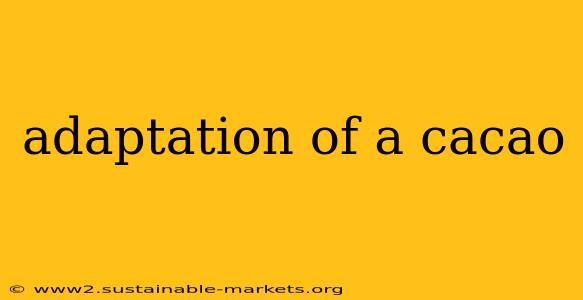Cacao, the raw ingredient behind chocolate, boasts a fascinating history of adaptation. Its journey from the humid rainforests of South America to its current global cultivation reveals a complex interplay between environmental pressures, human intervention, and the plant's remarkable resilience. Understanding this adaptation is crucial not only for appreciating the chocolate we enjoy but also for ensuring the future sustainability of cacao production.
From Rainforest Origins to Diverse Climates
The Theobroma cacao tree, cacao's botanical name, originated in the Amazon basin. Its natural habitat demands specific conditions: consistently warm temperatures (ideally between 70-80°F), high humidity (above 70%), and ample rainfall (60-100 inches annually). These conditions are crucial for its growth and the development of its pods, brimming with the beans that are the foundation of chocolate.
However, the success of cacao isn't solely confined to its original rainforest home. Over centuries, cultivation has spread across a wide range of tropical and subtropical regions, demonstrating the species' impressive adaptability. While thriving best in its native environment, cacao has shown the capacity to adapt to slightly different temperature ranges, rainfall patterns, and soil compositions. This adaptability, though, is not without limits, and understanding those limitations is crucial for responsible farming practices.
Key Adaptations Observed:
- Shade Tolerance: While cacao can tolerate some direct sunlight, it typically grows best under a canopy of shade trees. This adaptation protects the delicate leaves from intense sunlight and reduces water loss through transpiration. Farmers often employ agroforestry techniques, integrating shade trees with cacao plants to mimic its natural environment.
- Varietal Selection: The development of numerous cacao cultivars through selective breeding has been instrumental in expanding cacao's cultivation range. Different varieties exhibit varying degrees of tolerance to drought, disease, and specific soil conditions. This allows farmers to choose the most suitable variety for their particular location.
- Disease Resistance: Cacao is susceptible to a range of diseases, most notably black pod rot and witches' broom. Adapting to these threats involves developing disease-resistant varieties through breeding programs and employing integrated pest management techniques. This constant evolution of the plant and farming techniques is a key factor in maintaining production.
The Human Hand in Cacao's Adaptation
Human intervention has significantly influenced cacao's adaptation. Selective breeding and cultivation practices have played a pivotal role in shaping the plant's characteristics and expanding its geographic range. From ancient Mayan and Aztec civilizations meticulously cultivating cacao to modern agricultural techniques, human involvement has continuously molded the plant to meet diverse demands.
Challenges of Modern Cacao Cultivation:
- Climate Change: Rising temperatures and altered rainfall patterns pose significant threats to cacao cultivation. Many regions currently suitable for cacao production may become less so in the future, requiring adaptation strategies such as developing heat-tolerant varieties and implementing water-efficient irrigation systems.
- Disease Pressure: Global warming can exacerbate disease pressure, making the development of resistant cultivars even more critical. Integrated pest management and careful monitoring are essential tools for mitigating disease outbreaks.
- Soil Degradation: Intensive farming practices can lead to soil degradation, impacting cacao yield and quality. Sustainable farming techniques, such as crop rotation and cover cropping, are crucial for maintaining soil health and long-term cacao production.
Conclusion: A Future of Adaptable Cacao
The story of cacao's adaptation is a testament to the resilience of the plant and the ingenuity of human cultivation. However, the ongoing challenges posed by climate change and disease necessitate a continued focus on sustainable farming practices, research into disease-resistant varieties, and a deeper understanding of the plant's adaptive capabilities. Only through these combined efforts can we ensure the future of cacao production and the enjoyment of chocolate for generations to come. The adaptation of cacao is not just about the plant; it's a story of human innovation, environmental awareness, and the ongoing evolution of a beloved crop.

